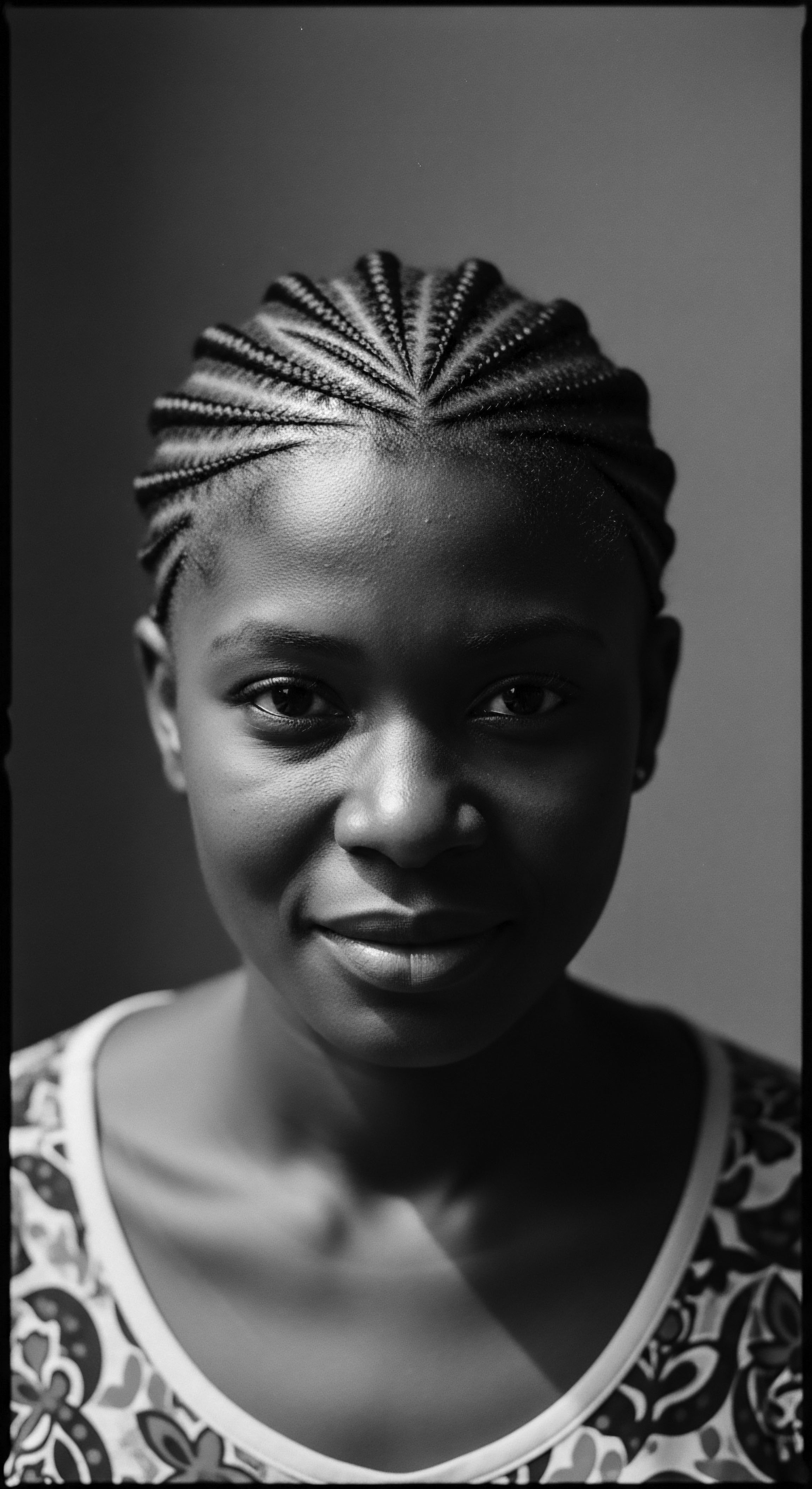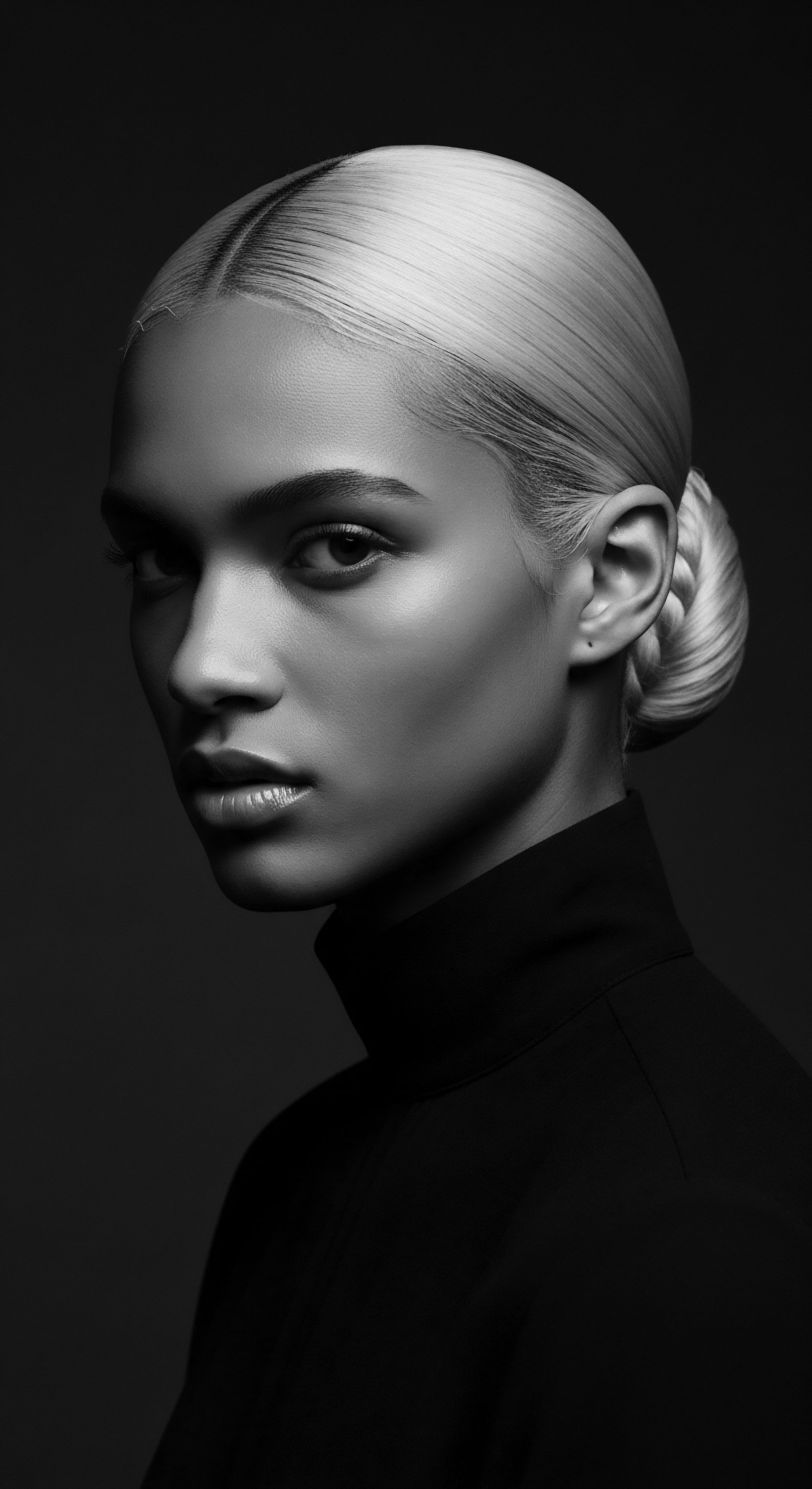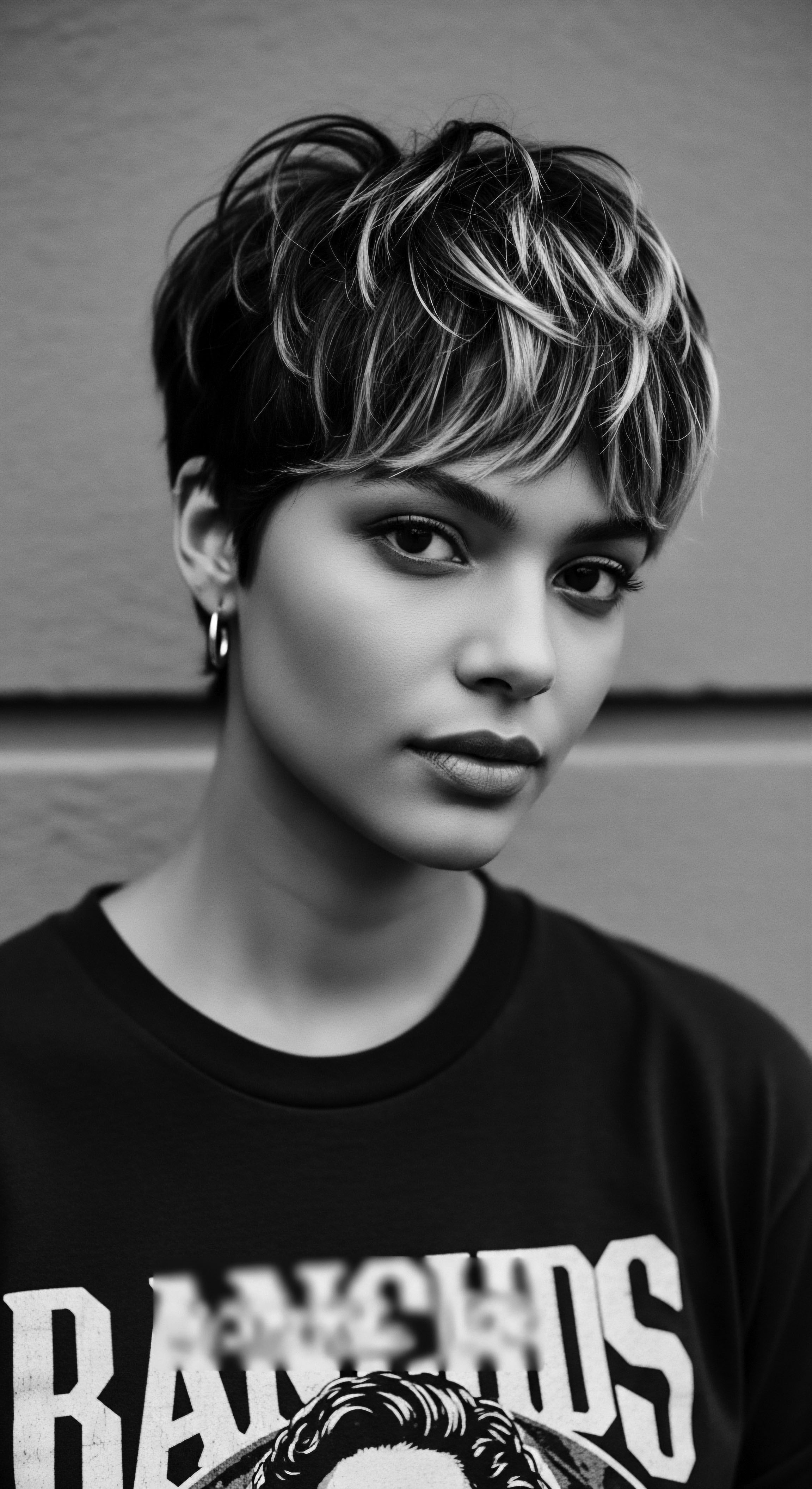
Roots
The journey of textured hair, a lineage stretching back through millennia, carries with it tales of resilience, ingenuity, and profound cultural memory. Each coil, kink, and wave holds a testament to survival, to practices honed over generations. For those whose ancestry traces through the vast landscapes of Africa and the diasporic passages beyond, hair is more than a biological outgrowth; it is a living archive, a sacred crown. Within this understanding, the unassuming oil, a simple extraction from plant or nut, takes on a monumental role.
Its molecular embrace, an invisible shield, has safeguarded this heritage, protecting strands from the harsh whisper of arid winds to the relentless tug of new worlds. To truly grasp how the molecular structures of oils protect textured hair lineage, one must listen to the whispers of ancient hands, feel the warmth of communal care, and appreciate the silent chemistry that binds past to present.

Hair’s Ancestral Architecture and Oil’s Embrace
Textured hair possesses a unique architecture, a spiral staircase of keratin proteins that sets it apart. The elliptical shape of the follicle gives rise to curls and coils, creating points of natural bending and twisting along the strand. At these bends, the outermost layer, the cuticle, tends to lift, leaving the inner cortex more susceptible to environmental stressors and moisture loss. This characteristic shape, while beautiful, presents a particular challenge ❉ maintaining hydration.
Historically, communities understood this intuitively, recognizing that these hair types craved a certain richness, a consistent anointing to retain suppleness and strength. The molecular structure of oils, particularly their fatty acid composition, provides a protective answer to this innate thirst.
Consider the hair fiber, a complex composite of the cuticle, cortex, and medulla. The cuticle, like overlapping roof tiles, functions as the primary defense. When healthy, these tiles lie flat, rendering the hair hydrophobic, or water-repelling. Damaged hair, conversely, features lifted cuticles, making the hair hydrophilic, prone to excessive water absorption, leading to frizz and breakage.
This repeated swelling and deswelling, known as hygral fatigue, weakens the hair over time. Oils, with their hydrophobic nature, create a barrier around the hair shaft, preventing too much water from entering, thereby maintaining the hair’s structural integrity and reducing the risk of fracture.
The enduring power of oils lies in their molecular embrace, forming a protective shroud for each precious strand.

Echoes of Lipid Wisdom ❉ Traditional Oils and Their Molecular Gifts
Across ancestral lands, certain oils rose to prominence, their efficacy perhaps understood through observation rather than laboratory analysis, yet profoundly effective. These traditional choices often possessed molecular structures ideally suited for textured hair’s needs. Shea Butter, for instance, a staple across West Africa, is rich in saturated fatty acids such as stearic acid.
While it may not deeply penetrate the hair fiber due to its larger molecular size, its protective nature as a sealant is unparalleled. It forms a film on the hair’s surface, minimizing moisture loss and adding a lustrous sheen.
Another ancestral ally is Coconut Oil, used for centuries in South Asia and parts of Africa. Its high concentration of lauric acid, a medium-chain fatty acid, gives it a unique ability to penetrate the hair shaft. This smaller molecular size allows it to slip past the cuticle and enter the cortex, bonding with hair proteins.
Research shows that coconut oil reduces protein loss in both virgin and treated hair when used as a pre-wash ritual. This ancient wisdom, passed through generations, finds a clear validation in modern scientific understanding.
Traditional oils frequently used for textured hair included:
- Coconut Oil ❉ Known for its ability to penetrate the hair shaft, reducing protein loss and providing deep conditioning.
- Olive Oil ❉ A favored choice in ancient Mediterranean and Middle Eastern traditions, it helps to soften strands and enhance elasticity.
- Shea Butter ❉ A West African treasure, it serves as a protective sealant, guarding against moisture loss and environmental stressors.
- Castor Oil ❉ Applied in ancient Egypt and still valued, its thick consistency helps coat hair, offering substantial protection and promoting strength.

Ritual
The ritual of hair care, a practice often performed with tenderness and deep intent, stands as a cornerstone of textured hair heritage. Hands moving with a rhythm inherited from grandmothers, oils applied with purpose, these acts transcend mere grooming; they are conduits of memory, resilience, and identity. Within these ceremonies, the molecular action of oils becomes intertwined with the cultural significance of care, a silent language spoken between generations. This section journeys into how these molecular structures became integral to both the ceremonial and daily styling practices that have defined textured hair lineage.

Anointing the Crown ❉ Oils in Ceremonial and Daily Practices
Hair oiling, a custom passed down through ages, extends beyond simple cosmetic use. Across African communities and within the diaspora, it has historically symbolized well-being, status, and community. From ancient Egyptian use of castor oil and honey to condition and strengthen hair, to West African traditions employing shea butter for moisture in dry climates, oils have been central to hair vitality. These practices were not isolated; they were communal, strengthening bonds as mothers braided their daughters’ hair, stories shared, and wisdom imparted.
The tactile interaction of hands, hair, and oil was, and remains, a powerful ritual. Sybille Rosado, a scholar of Black hair, argues that studying the “symbolic grammar of hair” is essential to understanding how culture is shared and disseminated throughout the diaspora, with grooming practices deeply tied to this collective memory. (Rosado, 2003, p. 61)
The application of oils before styling, particularly protective styles like braids and twists, reduces the friction inherent in manipulation. The lubricating properties of oils allow hair strands to align better, reducing snagging and breakage. This physical protection, directly linked to the oil’s molecular slipperiness, underpins the historical efficacy of these styling traditions. When women in ancestral communities would prepare hair for intricate designs, the oil was not an afterthought; it was a foundational step, preparing the delicate fibers for the tension of the style.

The Protective Veil ❉ Molecular Shield in Styling
The very act of styling textured hair, whether braiding, twisting, or coiling, puts stress on the individual hair strands. The unique curl pattern, with its bends and turns, means that these hair types are inherently more susceptible to mechanical damage compared to straight hair. Oils act as a protective veil, minimizing this stress.
Their molecular structure allows them to coat the hair shaft, reducing the coefficient of friction between strands. This lubricated surface helps prevent the cuticle scales from lifting further, maintaining a smoother, more coherent hair surface.
For instance, a pre-wash oil treatment, a long-standing practice in many hair care rituals, prevents excessive water absorption during washing. This is particularly vital for textured hair, which can swell rapidly with water due to lifted cuticles. By controlling this swelling, oils directly combat hygral fatigue.
Coconut oil, with its short carbon chains, is particularly effective at this, as it can penetrate the cortex and render the hair protein more hydrophobic. This ancient knowledge, validated by modern chemistry, explains why a grandmother’s insistence on oiling before washing held such profound power.
| Traditional Oil Coconut Oil |
| Primary Molecular Action on Hair Penetrates cortex, reduces protein loss, increases hydrophobicity. |
| Styling Benefit in Heritage Practices Minimizes swelling during washing, prepares hair for manipulation, reduces breakage. |
| Traditional Oil Shea Butter |
| Primary Molecular Action on Hair Forms protective film on cuticle, seals moisture, adds emollients. |
| Styling Benefit in Heritage Practices Holds protective styles, adds sheen, provides softness for braiding. |
| Traditional Oil Castor Oil |
| Primary Molecular Action on Hair Thick viscosity coats strands, enhances moisture retention. |
| Styling Benefit in Heritage Practices Adds weight and definition to curls, promotes strength in protective styles. |
| Traditional Oil Jojoba Oil |
| Primary Molecular Action on Hair Mimics scalp's sebum, conditions scalp, balances oil. |
| Styling Benefit in Heritage Practices Scalp health for long-term styles, reduces dryness under braids and twists. |
| Traditional Oil These oils, with their distinct molecular attributes, were chosen through generations of trial and ancestral wisdom, each serving a specific protective role in textured hair styling traditions. |
The deliberate choice of specific oils for different purposes—some for penetration, others for surface coating—was not random. It was an intuitive science, a heritage of empirical knowledge passed through family lines. The richness of a butter like shea for sealing moisture, or the lighter touch of a penetrating oil like coconut for deep conditioning, speaks to a sophisticated understanding of hair needs, long before electron microscopes revealed the invisible world of molecular bonds.
Ancestral care practices, steeped in oiling rituals, underscore a deep, intuitive grasp of hair’s molecular needs.

Relay
The legacy of textured hair care, sustained through generations, represents a relay of wisdom, a transfer of intimate knowledge about nature’s profound capacity to protect and nourish. This enduring journey from elemental biology and ancient practices to its role in voicing identity and shaping futures reveals the sophisticated interplay of molecular science and cultural continuity. The deep exploration of how molecular structures of oils shield textured hair lineage unveils a story not only of survival, but of sustained vitality.

Generational Gleam ❉ Oils in Sustained Wellness
For countless generations, particularly in West Africa, the shea tree, known as “karite” or “tree of life,” has provided a core component of daily wellness. The butter extracted from its nuts has been used for thousands of years in balms, soaps, and traditional medicines, including hair care. This isn’t just anecdotal.
The very composition of Shea Butter, with its high content of saturated fatty acids and unsaponifiable matter, offers remarkable emollient and protective properties. These molecular attributes create a durable barrier, which is especially beneficial in harsh climates, helping hair withstand intense sun exposure and dryness.
A powerful historical example of this sustained wellness comes from the Basara Tribe of Chad. For centuries, the Basara women have been known for their extremely long, strong hair, a practice deeply intertwined with their weekly application of an herb-infused mixture, often containing a blend of oils and animal fats, known as Chebe. They apply this mixture to their hair and then braid it to maintain length.
This practice, a testament to inherited knowledge, highlights how traditional methods, involving oils and fats, were not simply about aesthetics, but about length retention and hair strength in challenging environmental conditions. While modern science works to quantify the exact molecular interactions of Chebe, the demonstrable results of its use over generations affirm the deep, empirical understanding of protective oiling within this lineage.

The Silent Guardians ❉ Nighttime Nurturing and Molecular Repair
Nighttime rituals hold a special place in textured hair care, historically and presently. The use of headwraps, scarves, and later, satin bonnets, wasn’t merely for aesthetic appeal or neatness. These accessories served as silent guardians, creating a micro-environment that amplified the protective qualities of applied oils.
The molecular films formed by oils, particularly those with larger fatty acid chains that sit on the hair surface, prevent the mechanical abrasion that occurs when hair rubs against rough pillowcases. This barrier also minimizes moisture evaporation, ensuring the hair remains hydrated through the night.
Consider the science of lipids. Lipids are naturally present in the outermost layer of hair, the cuticle, and on the hair’s surface, acting as a protective film. These lipids, including ceramides and fatty acids, seal in moisture and shield against harmful elements. If this lipid layer is damaged, hair becomes dry and prone to breakage.
Oils, when applied, help to replenish this layer, smoothing cuticle scales and preventing moisture loss. This means that the nighttime application of oils, often combined with a protective covering, creates an optimal environment for hair to rest and recover, minimizing the very wear and tear that leads to fragility.
Key functions of lipids in hair health:
- Moisture Retention ❉ Lipids create a film that seals the cuticle, minimizing water evaporation.
- Hydrophobicity ❉ They aid hair’s ability to repel excessive water, preventing harmful swelling.
- Barrier Protection ❉ Lipids shield hair from environmental aggressors and mechanical stress.

The Chemist’s Insight ❉ Validation of Ancestral Practices
Modern chemical analysis provides a deeper appreciation for the wisdom embedded in ancestral hair care. For example, the presence of oils rich in Oleic Acid and Linoleic Acid—like those found in argan and olive oil—contributes to hair conditioning and elasticity. These fatty acids, while not always deeply penetrating, coat the hair, reducing water absorption and providing a glossy appearance. The historical reliance on these oils across various cultures, from Moroccan argan oil to ancient Greek olive oil, speaks volumes of their perceived effectiveness.
The precise balance of penetrating and sealing oils in a hair care regimen, a concept often taught through observation in heritage practices, is now understood through molecular weight and fatty acid saturation. Short-chain fatty acids, primarily found in oils like coconut, absorb into the hair cortex, strengthening it from within by bonding with proteins. Longer-chain fatty acids, prevalent in oils like castor, tend to coat the hair, offering a barrier.
The ancestral understanding of applying certain oils for “strength” and others for “shine” was, in essence, an intuitive grasp of molecular chemistry. This convergence of ancient practice and contemporary science reinforces the authority of handed-down traditions, proving their sustained benefit for textured hair lineage.
The molecular composition of traditional oils offers scientific validation for age-old hair care practices, bridging ancestral wisdom with modern understanding.
The interplay of oil types, from penetrating to sealing, reveals a sophisticated understanding that was not written in textbooks but in the very motions of care.
- Penetrating Oils ❉ Oils with short or medium carbon chains, like coconut oil (lauric acid), absorb into the hair shaft, reducing protein loss and improving hydrophobicity from within.
- Sealing Oils ❉ Oils with longer carbon chains or those that are predominantly saturated, such as shea butter or castor oil, coat the hair surface, providing a protective film that traps moisture and reduces friction.

Reflection
The story of oils protecting textured hair lineage is more than a scientific account; it is a resonant saga of connection, survival, and enduring beauty. Each application, each gentle stroke, echoes practices stretching back through time, linking us to a heritage of profound wisdom. The molecular embrace of these botanical allies speaks to a continuous thread of care, passed from hand to hand, generation to generation, serving as a testament to the ingenious ways communities have preserved their identity and adorned their crowns amidst challenging currents. The very strands that coil and curl hold memories of resilience, and in the whisper of oil through them, we hear the enduring soul of a strand, ever strong, ever vibrant, ever free.

References
- Bundles, A. (2001). On Her Own Ground ❉ The Life and Times of Madam C. J. Walker. Scribner.
- Ottley, R. (1943). New World A-Coming ❉ Inside Black America. Houghton Mifflin.
- Rosado, S. (2003). Black Hair ❉ A History of Identification and Style. Duke University Press.
- Rosado, S. (2007). The Grammar of Hair ❉ Identity and Communication in the African Diaspora. NYU Press.
- Zeleza, P. T. (2005). The Transformation of Africa, Volume 2 ❉ The Agrarian and Health Transitions. Ohio University Press.
